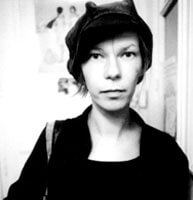Arja Katariiina Hyytiäinen was born in 1974 in Turku, Finland. She is a graduate of the Department of Documentary Photography at FAMU (Prague, Czech Republic). Hyytiäinen is interested in self-experienced stories. Thanks to her classical documentary background, her works often reflect a combination of self-experienced subjective reality and fictional intuitive storytelling. She has published two books ‘Distance Now’ and ‘Arja Hyytiäinen – Cahiers’. She is the recipient of the Critical Photography Prize, Prix Kodak in France 2006, as well as the Grand Prix at the 2007 Lodz Festival. Since 2006, Arja Hyytiäinen’s work has been distributed by Agence VU’. She has been based in La Rochelle, France, since 2010.
Source: EPEA
For the Finn Arja Hyytiäinen photography is a means of entering into the lives of others. It is an echo of personal experiences that help enlarge her understanding – and ours. The often sombre black and white photographs that she took in the port city of Marseille underscore the feeling that she got there, as if the residents had an almost permanent mental hangover. She shows the disfigured faces of people in illegal bars, she evokes the sound of fans, wind and footsteps that echo against shuttered windows, and depicts the restless energy of the night, which shades into a day where the heat envelopes your body like a second skin. The city, she says, left an emotional mark behind on her soul. With her subjective images she does the same for the viewer.
In the space of only a couple years Arja Hyytiäinen (Finland, 1974) has made a name for herself as a contemporary street photographer, with a subjective, cinematographic style. She spent considerable time in Eastern Europe and was awarded the Kodak Prize for Critical Photography and the Polish Fotofestival Grand Prix. Hyytiäinen lives by turns in Paris and Berlin.
Source: Noorderlicht
"Completely contemporary, free and demanding, the work of Arja Katarrina Hyytiäinen is part of the today’s school, from the tradition of the street photography, and that has replaced its form to claim the author status. Saying its necessity and its singularity, devoting itself to subjectivity, and influenced by cinematographic aesthetic, the whole work, extremely respectful for representing people, is from a new contemporary humanism," according to Christian Caujolle.
In just a few years, she has acquired a reputation throughout Europe, particularly where she has lived in Eastern Europe, and become known through her solo exhibitions (Czech Republic, Poland, Hungary, Moldavia, Slovenia). In 2006 she was awarded by the Kodak Prize for Critical Photography and the Fotoestiwal (Poland) Grand Prix in 2007.
Source: Agence VU
